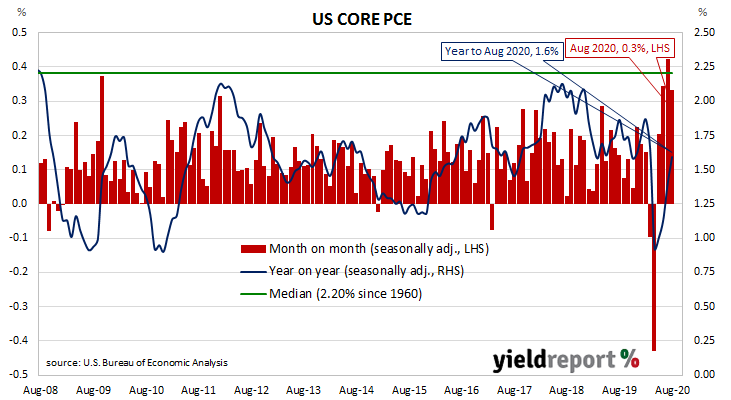Summary: US Fed’s favoured inflation measure rises 0.3%; in line with market expectations; previous month revised up; annual rate up again; reaction by Treasury bond yields mixed.
One of the US Fed’s favoured measures of inflation is the change in the core personal consumption expenditures (PCE) price index. After hitting the Fed’s target at the time of 2.0% in mid-2018, the annual rate then hovered in a range between 1.8% and 2.0% before it eased back to a range between 1.5% and 1.8% through 2019. It then plummeted below 1.0% in April 2020 before rising in recent months.
The latest figures have now been published by the Bureau of Economic Analysis as part of the August personal income and expenditures report. Core PCE prices increased by 0.3% over the month, in line with expectations but lower than July’s increase after it was revised up from 0.3%. On a 12-month basis, the core PCE inflation rate accelerated for a fourth consecutive month, from July’s revised rate of 1.4% to 1.6%.

US Treasury bond yields reacted in a mixed fashion on the day. By the close of business, the 2-year Treasury bond yield had lost 2bps to 0.13%, the 10-year yield remained unchanged at 0.68% while the 30-year yield finished 1bp higher at 1.46%.
In terms of US Fed policy, expectations of any change in the federal funds rate over the next 12 months retained a slight easing bias. OIS contracts for September implied an effective federal funds rate of 0.077%, about 1bp below the current spot rate.
The core version of PCE strips out energy and food components, which are volatile from month to month, in an attempt to identify the prevailing trend. It’s not the only measure of inflation used by the Fed; it also tracks the Consumer Price Index (CPI) and the Producer Price Index (PPI) from the Department of Labor. However, it is the one measure which is most often referred to in FOMC minutes.

